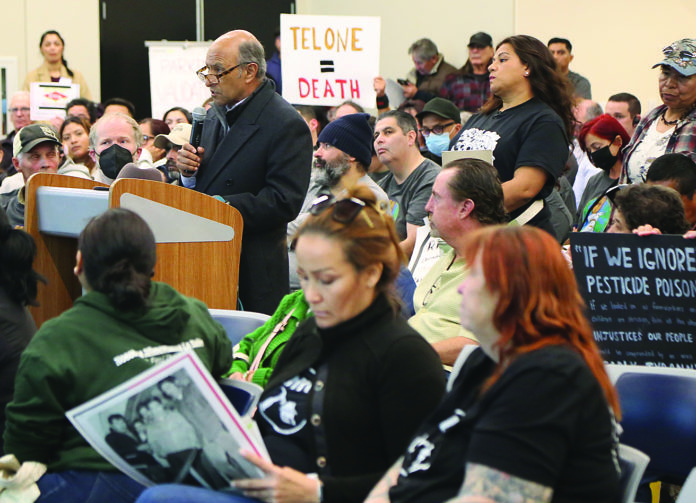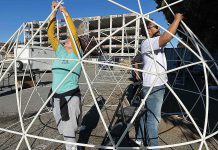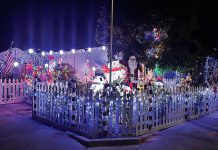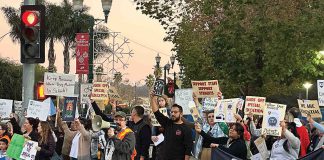
The Department of Pesticide Regulation’s (DPR) held a public hearing Jan. 16 at the National Steinbeck Center in Salinas to address a new draft regulation for Telone, a pesticide also known by the chemical name 1,3-dichloropropene.
Protesters say the regulations proposed by the DPR allow 14 times more of the pesticide than is recommended by the California Office of Environmental Health Hazard Assessment (OEHHA).
DPR’s recommended level is the same from the pesticide’s manufacturer, Dow Chemical.
Telone is a cancer-causing fumigant pesticide and Toxic Air Contaminant that is banned in 40 countries, but is the third most-used pesticide in California.
Dozens of community members—including scores of area farmworkers—took turns at a microphone to speak out against the use of 1,3-D, citing a host of health problems stemming from the fumigant’s use.
“There is no question that 1,3-D is a carcinogen,” said Antonio Velasco, a family physician who has studied protocols for treating pesticide-poisoning victims. “My question to you is, ‘why do you continue to use it?’”
At one point the event was interrupted by more than a dozen protesters surrounding the podium in a mock “die-in”, while others unfurled large bilingual banners saying “DPR is racist!” and the crowd of over 100 chanted “DPR, you can’t hide; we can see your racist side,” according to Mark Weller of Californians for Pesticide Reform.
“Speaker after speaker expressed anger and frustration that DPR has not justified the use of cancer risk targets that allow children and residents to be exposed to fourteen times more 1,3-D than adult workers in neighboring fields,” Weller said. “It’s good that DPR is finally using the OEHHA findings for some. But why not all? It is not scientific to say that children – and we’re talking about mostly Latino children here – have a different lifetime cancer risk tolerance than adults.”
The California Office of Environmental Health Hazard Assessment (OEHHA) in 2022 issued a Prop 65 safe harbor level—the maximum exposure amount determined to be safe—for 1,3-D that converts to a daily air concentration of 0.04 parts per billion. The 1,3-D air concentrations at the six active state pesticide air-monitors, including those in Pajaro, Santa Maria, and Oxnard, have exceeded OEHHA’s lifetime cancer risk level, since testing started in 2011.
“While much of the world is banning 1,3-D, California is going in the wrong direction,” said Safe Ag Safe Schools and Central Coast organizer Yanely Martinez. “Our regulators must follow health protective science, but DPR’s policies ignore the science in favor of protecting Dow Chemical’s profits. They should be protecting our health. This is a racist policy.”
Woody Rehanek of Watsonville, also a member of Safe Ag Safe Schools, said that there are 50 conventional chemical farms, nurseries, and greenhouses within a quarter-mile of many PVUSD schools.
“The strawberry and raspberry growers among them are applying drift-prone 1,3-D, a carcinogen and toxic air contaminant banned in 34 countries. This is a significant public health hazard for local children, school staff, residents, and farmworkers,” he said.












